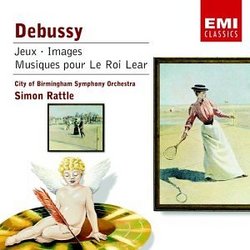| All Artists: Debussy, Bham, Rattle Title: Images: Jeux Members Wishing: 0 Total Copies: 0 Label: EMI Classics Original Release Date: 1/1/2000 Re-Release Date: 1/13/2004 Genre: Classical Styles: Chamber Music, Historical Periods, Classical (c.1770-1830) Number of Discs: 1 SwapaCD Credits: 1 UPCs: 724357521826, 072435752182 |
Search - Debussy, Bham, Rattle :: Images: Jeux
CD Details |
CD ReviewsA very good album, strange combination of pieces G. Stewart | Chesapeake, VA USA | 11/10/2007 (4 out of 5 stars) "For starters, in case you haven't read my profile or some of my other reviews, I LOVE DEBUSSY. He is my favorite composer. Just want that to be stated before I continue...
I'm not quite sure how EMI came to the decision to put these pieces together on 1 CD. One might argue that 'Jeux' and 'Le Roi Lear' are small pieces composed for a small orchestra, but Images is foreign in both composition and layout of the movements; the 2nd movement being triptych and, thus, making the piece essentially a composition of 5 movements. At any rate, all 3 are conducted by Sir Simon Rattle and performed well by (stranger still) The City of Birmingham Symphony Orchestra?!?! No offense to the fine city of Birmingham, but they are not exactly the center of cultural revolution (perhaps the physical center of England?; I don't know). But they certainly hold their own and the performance is lovely and respectfully performed. Recording, mixing and sound are all very nice. "Musiques pour Le Roi Lear" was composed in 1904 for a Paris performance of Shakespeare's play. It is 2 short movements totalling less than 5 minutes. "Fanfare" is only 1 1/2 minutes long and is a typical fanfare piece with booming horns and percussion. The 2nd movement, "Le Sommeil de Lear" (The Sleep of Lear, or Lear's sleep) is a soft medley that is both beautiful and melancholy, perfectly indicative of a dream-like state, as the title suggests. Sharp, punctuated harp is sparsely placed behind soft horns and strings. The entire piece is soft, slightly dissonant and utterly amazing. It is one of my favorite pieces by Debussy. "Jeux" was Debussy's last composition for Orchestra. It was written for a choreographer as a piece that would be for a ballet that, originally, was intended to involve such unorthodox concepts as a homosexual tryst, a plane crash and other "games", which is the literal translation of the title. The ballet, or 'Danced Poem', performed was decidedly different and involved a tennis match, a lost tennis ball, a boy and two girls; the tone of the ballet was overtly sexual and it was not well received. It did not help that a giant cacaphony followed the premier of "Rite of Spring" by Stravinsky when it was performed only days later by the same group. But this does not take away from the fact that the piece itself is beautiful. The music is moving and is, although Debussy didn't know when he was writing the piece that it was his last orchestra work, still a wonderful culmination and combination of his many techniques in composing for orchestra. The album is finished with the "Images", a composition that Debussy spent 7 years working at completing; starting it in 1905 and finally finishing it in 1912. It opens with "Gigues", ironically a term that would indicate fast movement, music for dance, but this piece is softer, more complex and very... well..., undanceable (if that's a word); the movement is atonal, punctuated in many parts and follows no particular metre throughout. That is not to say that it is not an enjoyable piece, it is just titled strangely. The 2nd movement, as stated above, is actually broken in to 3 movments. The movement as a whole is title "Iberia" and comprises three pieces. i. "Par les rues et par les chemins" (In the streets and by-ways) which is evocative of the business of such places. The tempo is quick and the music bold as the piece opens. Slow and peaceful string work encompasses the middle of the piece before the horns join again and the music builds back to the main theme. ii. "Les Parfums de la nuit" (The fragrance of the night) is very soft, soothing and eerie. The piece evokes snake-like movement, like a cartoon scent moving on the breeze to a character's nostrils, that is perfectly in keeping with the title. iii. "Le matin d'un jour de fete" (The morning of the festival day) opens so quietly that you feel you are waking, but it builds quickly and loudly to a very festive and spirited orchestral jubilee. The instruments move, thrust and parry, dancing around and amongst one another in a wonderful combination of musical cooperation. This is the best known piece from the movement known as "Iberia" and I believe that of the entire composition ("Images") it is probably the most recognizable as well. The closing movement, "Rondes de printemps" (Round dances of spring) is very active, like the third piece from the second movement, but it returns to an more controlled, central theme played by the entire orchestra in unison with moments of sectional flourish (strings, woodwinds) but generally the movement is more structured and colaborative. All 3 pieces, although very different in make-up, purpose and sound are performed wonderfully. I would highly recommend this bargain priced CD as it is an excellent value and it is a very good introduction to the many differing sounds that Debussy offered." |

